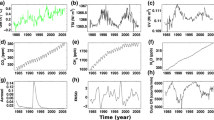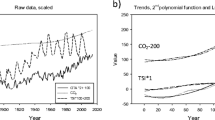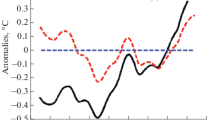Abstract
Based on univariate correlation and coherence analyses and considering the physical basis of the relationships, a simple multiforced (multiple) statistical concept is used which correlates observational climatic time series simultaneously with volcanic, solar, ENSO, and the anthropogenic greenhouse gases forcing. This is appropriate to remove some natural climate noise in the observed data and to evaluate the components (signals) possibly due to the anthropogenic greenhouse gas forcing (CO2, or “equivalent” CO2 implying additional gases) during industrial time. In this paper, we apply this technique to 100 global “box” data time series 1890–1985, of the surface air temperature, using observed data from Hansen and Lebedeff. The results are presented in terms of latitudinal-seasonal and regional trends, where the observed trend patterns are compared with the hypothetical signals (statistical assessments) possibly due to anthropogenic greenhouse forcing. These latter signals can be amplified to enable a comparison with corresponding results from general circulation model (GCM) CO2 doubling experiments. These observed-statistical assessments lead to results which are, at least qualitatively and in respect to the zonal mean temperatures, very similar to some GCM experiments indicating the maximum CO2 doubling signals (statistical assessment > 12 K) in the arctic winter. However, these signals are moderate in the tropics and in the Southern Hemisphere (global average 2.8–4.4 K). As far as the “industrial” signals are concerned (observed period) these signals are somewhat larger (maximum 7 K, global average 0.5–0.9 K) than the observed trends (maximum 5 K, global average 0.5 K). Phase shifts of cause and effect may amplify these signals but are very uncertain.
Similar content being viewed by others
References
Arrhenius S (1896) On the influence of carbonic acid in the air upon the atmosphere of the ground. Philos Mag J Sci (Series 5) 41:237–276
Bolin B, Dö:os BR, Jager J, Warrick RA (eds) (1986) The greenhouse effect, climatic change, and ecosystems. Wiley, Chichester
Cress A, Schönwiese CD (1990) Vulkanische Einflüsse auf die bodennahe und stratospharische Lufttemperatur der Erde. Report No. 82 Inst Meteorol Geophys Univ Frankfurt (FRG)
Flohn H, Krahe P, Hense A (1987) Trends of tropospheric temperature and water vapour in the Indo-Pacific region during the last 20 years. Trop Ocean-Atm Newslett 38:11–13
Gilliland RL (1982) Solar, volcanic and CO2 forcing of recent climatic changes. Clim Change 4:111–131
Groveman DS, Landsberg HE (1979) Reconstruction of northern hemisphere temperature: 1579–1880. University of Maryland, Dept. of Meteorol, Publ No 79–181:pp 46+59
Hansen J, Lebedeff S (1987) Global trends of measured surface air temperature. J Geophys Res (1311) 92:13345–13372
Hansen J, Lebedeff S (1988) Global surface air temperatures: update through 1987. Geophys Res Letters 15:323–326
IPCC (Intergovernmental Panel on Climate Change, Houghton JT, Jenkins GJ, Ephraums JJ, eds) (1990) Climate change. The IPCC scientific assessment. Cambridge Univ Press, Cambridge
Jacoby GC, D'Arrigo R (1989) Reconstructed northern hemisphere annual temperature since 1671 based on high-latitude tree-ring data from North America. Clim Change 14:39–59
Jones PD (1988) Hemispheric surface air temperature variations: recent trends and an update to 1987. J Climate 1:654–660
Lamb HH (1983) Update of the chronology assessments of the volcanic dust veil index. Clim Monitor 12:79–90
Mitchell JFB, Senior CA, Ingram WJ (1989) CO2 and climate: a missing feedback? Nature 341:132–134
Neftel A, Moor E, Oeschger H, Stauffer B (1985) Evidence from polar ice cores for the increase in atmospheric CO2 in the past two centuries. Nature 315:45–47
Schlesinger ME, Mitchell JFB (1987) Climate model simulations of the equilibrium climate response to increased carbon dioxide. Rev Geophysics 25:760–798
Schlesinger ME (1991) (ed) Greenhouse-gas-induced climatic change: a critical appraisal of simulations and observations. Elsevier, Amsterdam
Schneider U, Schönwiese CD (1989) Some statistical characteristics of El Niño/southern oscillation and North Atlantic oscillation indices. Atmósfera 2:167–180
Schönwiese CD (1983) Northern Hemisphere temperature statistics and forcing. Part A: 1881–1980. Arch Met Geoph Biocl Ser. B 32:337–360
Schönwiese CD (1987) Observational assessments of the hemispheric and global climate response to increasing greenhouse gases. Contr Atmos Physics 60:48–64
Schönwiese CD (1988) Volcanic activity parameters and volcanism-climate relationship within the recent centuries. Atmösfera 1:141–156
Schönwiese CD, Cress A (1988) An improved Northern Hemisphere volcanic activity parameter based on the Smithsonian chronology. Meteorol Rdsch 41:89–92
Schönwiese CD, Malcher J (1987) The CO2 temperature response. A comparison of the results from general circulation models with statistical assessments. J Climatol 7:215–229
Schönwiese CD, Birrong W, Schneider U, Stähler U, Ullrich R (1990) Statistische Analyse des Zusammenhangs säkularer Klimaschwankungen mit externen Einflußgrößen und Zirkulationsparametern. Report No. 84, Inst Meteorol Geophys Univ Frankfurt (FRG)
Schönwiese CD, Runge K (1991) Some updated statistical assessments of the temperature response to increased greenhouse gases. Internat J Climatol 11:237–250
Simkin T, Siebert L, McClelland L, Bridge D, Newhall C, Latter JH (1981) Volcanoes of the world. Smithsonian Institution, Hutchinson, supplements (1985)
Tricot C, Berger A (1987) Modelling the equilibrium and transient response of global temperature to the past and future trace gas concentrations. Clim Dyn 2:39–61
USDOE (US Department of Energy) (1985) MacCracken MC, Luther FM (eds) Detecting the climate effects of increasing carbon dioxide. DOE/ER-0235
Vinnikov KY, Groisman PY, Lugina KM (1990) The empirical data on modern climate changes. J Climate 3:662–677
Washington WM, Meehl GA (1989) Climate sensitivity due to increased CO2: experiments with a coupled atmosphere and ocean general circulation model. Clim Dyn 4:1–38
World Meteorological Organization (1979) Proceedings of the World Climate Conference. WMO Publ. No. 537
Author information
Authors and Affiliations
Rights and permissions
About this article
Cite this article
Schönwiese, CD., Stähler, U. Multiforced statistical assessments of greenhouse-gas-induced surface air temperature change 1890–1985. Climate Dynamics 6, 23–33 (1991). https://doi.org/10.1007/BF00210579
Received:
Accepted:
Issue Date:
DOI: https://doi.org/10.1007/BF00210579




